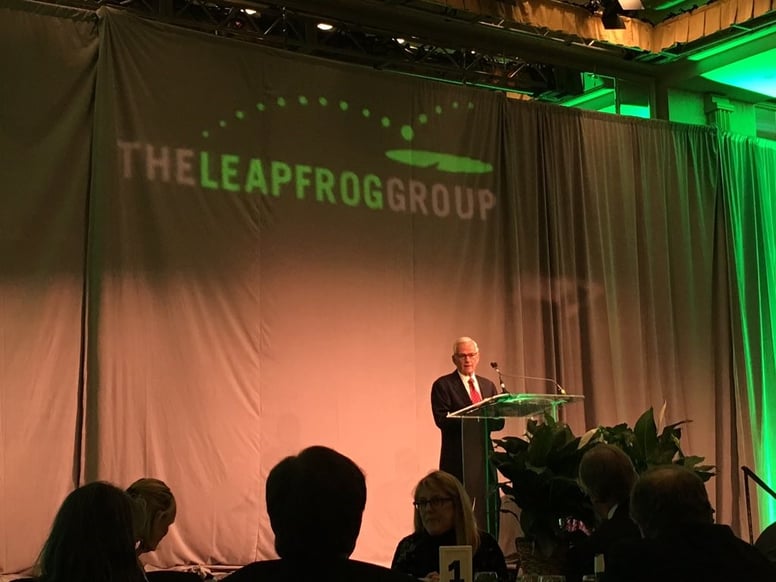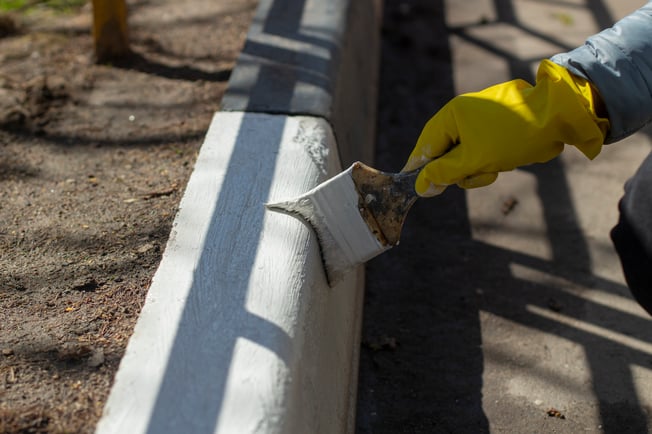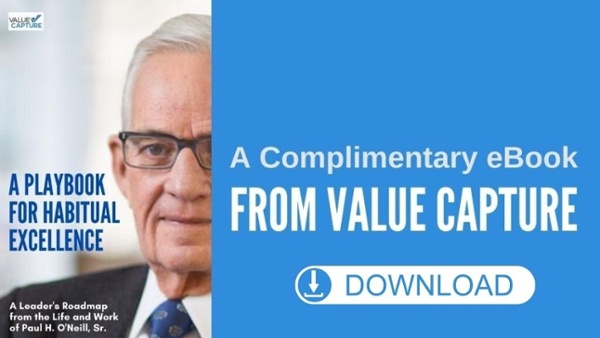Reflections, Memories, and Thoughts on Paul O’Neill, Sr.
In the three-and-a-half years since the passing of Paul O’Neill, Sr., each of us at Value Capture continues to reflect upon, learn from, and teach the core principles and values by which he lived and led.
So, as we celebrate Paul’s life and birthday (December 4), we gather thoughts from our team and share them here with you in this post. We encourage you to share your thoughts either in the Comments section below or at the Paul O’Neill Legacy site.
There have been multiple case studies, articles, and books that discuss the way that Paul led various organizations (such as Alcoa and the U.S. Treasury). Indeed, Value Capture has published ebooks about his leadership principles and how essential they are to many healthcare leaders in their daily work. We continue to watch videos of his speeches and find new insights and stories that inform and inspire us.
But as we are continually guided by the model of Paull’s leadership philosophy and practices, we recognize that he was simply living his personal principles in the context of leading others.
In other words, Paul O’Neill was a man of principle, whose actions were rooted in principles, regardless of whether he was the U.S. Treasury Secretary, giving a speech to a gathering of healthcare executives, or having lunch with a new Value Capture employee.
In the true spirit of Paul, each of us, personally and professionally, aspires toward the theoretical limit of perfect performance, or habitual excellence, as he called it. We recognize, of course, that humans are imperfect, but experience teaches us that the force of striving for perfection – with the mindset and behaviors rooted in fundamental principles – is truly powerful and impactful.
Here are some of those stories:
People-Focused Leadership
Melissa Moore
 I joined Value Capture in 2016 to support our communications and marketing efforts. I had no Lean or healthcare background; the extent of my understanding of Value Capture (prior to my first day) came from our website and other such materials.
I joined Value Capture in 2016 to support our communications and marketing efforts. I had no Lean or healthcare background; the extent of my understanding of Value Capture (prior to my first day) came from our website and other such materials.
One thing particularly stands out to me from our site: Paul’s speech on The Irreducible Components of Leadership.
Paul’s words resonated strongly (and still do), and I thought:
“This is what people-focused leadership looks like.”
In one of my first few days in the office, we had lunch brought in so I could get to know some of the team a bit. The lunch was in Paul’s office (which adjoined our Value Capture office and had a bigger conference room). I was intimidated at the thought of meeting Paul and asked Ken Segel if I should address Paul by his first name or call him Mr. O’Neill. Ken paused a moment and then advised that I should feel comfortable either way, that Paul was not a man of titles or formalities.
Paul, as he always did, wore a crisp white dress shirt and tie, and as we sat in the conference room, I somehow felt both in awe and at ease. I was awed by the many artifacts of Paul’s achievements and honors that filled a wall in the room, as well as photos of him with various members of President Bush’s Cabinet, letters from other Presidents and government leaders, and more.
Paul himself exuded genuine interest in me, my background, and how my first few days were going. As we ate our box lunches (sandwich, chips, a pickle, and a cookie), we all chatted comfortably. I could hardly believe that I felt so easy in the company of someone who clearly was a great man.
I soon realized that the bedrock upon which Paul engaged with people was respect – a truly heartfelt and active respect for every person.
I treasure that lunch, as well as every interaction I had with Paul from there forward. Whether we simply greeted each other as we passed in the hall or were in a meeting together, or he was signing a dollar bill for my colleagues and me, I know that I have been truly blessed to have spent time with Paul O’Neill.
Standing Behind the Goal of Zero Harm
Ken Segel
One moment when the power of Paul O’Neill’s vision and framework to help teams unlock far greater possibilities than they imagined came relatively early in our connection and the early efforts to first conceive and then accomplish “zero harm” work in healthcare, which Paul both inspired and then guided those willing to the “how.”
It came in late 1999, during the organizing year for the Pittsburgh Regional Healthcare Initiative. PRHI was formed as a group of competing hospital and insurance company CEOs, corporate CEOs, physician leaders, union and patient representatives (and even the Pennsylvania Attorney General), who guided the agenda setting, having to agree on the goals and then put their institutions behind it if anything was to be accomplished.
The whole idea introduced by O’Neill was that one foundational aim should be to ELIMINATE harm, starting with healthcare-associated infections and medication errors. This was a huge element for debate, with both excitement and lots of pushback, for months.
As alignment gradually developed, those pushing back also upped the intensity of their concerns, and it wasn’t always easy to know where it would come from – even those sympathetic with the goal were in some ways scared about taking on something so audacious.
So at a pivotal meeting, when the goal to eliminate specific healthcare-associated infections was to be set, one of the key physician leaders spoke up strongly against the goal of zero, employing a familiar tactic of both relying on his knowledge of the current clinical science and condescending to a lay person.
“Paul,” he said, “we don’t even know the science of how we’d completely eliminate these infections yet, and I’d hate you to look foolish rolling out such a goal.”
The whole room fell silent for several seconds, some reluctant leaders certainly thinking that the corporate non-clinical CEO had been ”shown up” and that we would now retreat to a less ambitious goal, or retreat altogether.
Instead, after a thoughtful pause, Paul responded with great energy, addressing the physician first by name and said,
“That’s great! If some of the basic science isn’t yet known, why can’t Pittsburgh be the region where we have banded together as a whole medical community together with our great research universities to be the place that goes out and gets the NIH grants and whatever else we need to figure the science out as one step toward eliminating these harms? That’s what I’m trying to show – if we as a region put our minds together to do great things, nothing will be able to stop us.”
His energy and powerful reframing surged electrically to the rest of the room, and the whole discussion was transformed. The goal was set and “next level” thinking became the baseline …
This moment solidified the start for what ultimately would be a CDC-certified drop of one infection rate by more than two-thirds, and its complete elimination at many area institutions, proving it was possible, just as Paul indicated it would be.
Practicing What He Preached
Mark Graban
Back in December 2015, I was able to attend the annual gala for The Leapfrog Group in Washington, DC. Quite appropriately, they had Mr. O’Neill there as a keynote speaker – perfect for an audience that’s committed to improving healthcare safety.

Not long into his talk, as I remember it, the fire alarm went off. Oh no!
True to form, Mr. O’Neill took the fire alarm seriously, even if we might have all guessed that it was quite likely a false alarm. Of course, he led the evacuation efforts out of the ballroom (meaning he stopped speaking and encouraged everyone to leave, not that he was trying to be first out).
After a few minutes, the alarm stopped going off, and everybody filed back into the ballroom.
But yet again, later into his speech, the alarm started going off yet again. Unfazed by the previous false alarm, he stopped the led the way – safety first!
I remember seeing him in the stairwell. He shrugged and looked a little exasperated, but I will never forget how his principle-based actions around always putting safety first and taking all safety risks seriously lined up with his words.
That’s the sign of a true leader and, while the interruptions were annoying, I’m glad I saw him practicing what he preached – walking the talk.
Mission to Improve Patient Safety
John Ervin
In 2012, at Mark Graban book signing event, I met the former senior executive of an international chemical company who had worked for Paul O’Neill.
As we spoke about healthcare, Jim could not believe we did not have more of a strategic focus on preventing patient harm. Jim told me about Paul’s work at Alcoa and their Journey to the zero employee harm strategy. I have shared that PowerPoint presentation with every firm I've worked at in healthcare.
It’s ironic that today, I find myself working with Value Capture and supporting their mission to improve patient safety.
Embracing the Role of Coach
John Collodora
Mr. O'Neill personified what is possible when a leader embraces the role of coach. He shared with me his curiosity and love of learning from direct observation of how work was being performed and also through a reflection process.
Mr. O’Neill’s famous three questions demonstrate his respect for people and interest in understanding and removing barriers so that they could perform at their best to achieve results. Mr. O’Neill also asked more direct questions to help his leaders achieve results. The questions focused on facts, using data to see trends and understand the cause of the particular trend, either improving or declining, coaching toward experiments, and finally to share the learning throughout the organization.
I am inspired by the legacy that Mr. O'Neill left in the values and the curiosity of those who worked directly for him and who are now sharing those principles forward as coaches. Mr. O’Neill embodied his famous quote:
"With leadership, anything is possible. Without it, nothing is possible"
He created an enduring legacy and a passion in others to achieve zero harm.
You Need to "Paint the Curbs"
Lisa Beckwith
Mr. O’Neill taught me to work with leaders to get them to “paint the curbs.” He would reference a story about an employee who tripped while walking because s/he didn’t see the curb of a sidewalk.
Oftentimes, that is the end of the story. We can probably all remember a time when we were that person tripping on the curb.

Mr. O’Neill continued the story. In an organization that strives to be excellent at everything that we do, the story doesn’t end there. Immediately, the people who were responsible for the environment of the organization worked to prevent the problem from happening again. They painted the curb yellow so that it could be seen even in darkness.
The story doesn’t end there either. They also did an assessment of all of the other sidewalks and painted the curbs that had the same risk of someone tripping by not seeing them.
“Painting the curbs” became his “code” message to our Value Capture team to move leaders to action, quickly, to eliminate harm from occurring.
It shouldn’t take months to put a fancy system in place. Take care of people quickly.
What does it take and how can Value Capture advisors help leaders to move toward action? “Paint the curbs” is a mindset.
- Develop “eyes to see” harm.
- Embrace the theoretical limit of zero harm.
- Set the expectation that when harm occurs, we will prevent it from ever happening again to another person.
- Engage people.
- Respond. Act. Do. It takes actual action to eliminate harm.
- Learn from everything that's gone wrong.
- Seek out other areas in the organization that are exposed to the same risks and DO something to prevent it there.
I have a “paint the curbs” mindset, and I think about it often when I work with clients and in my own personal life when I see a risk or experience harm.
If you see me walking through the city and smiling for no apparent reason, I am probably observing the yellow-painted curb and thinking fondly of Mr. O’Neill.
Bravery to Stand Up for What You Believe In
Bill Boyd
One of my favorite learnings from Paul comes from his focus on safety and his willingness (bravery) to stand for what he believed.
We say that safety is an unarguable goal, but it sounded like the shareholders would have argued otherwise when he took his CEO role at Alcoa.
No individual wants to be harmed at work (or elsewhere), but that unarguable goal can seem conflicting when others don’t believe safety is the top priority.
What I’ve heard Paul did was take a stand and weather the storm that would come with making a focus on worker safety the foundation.
Not a value or a priority, the precondition.
This isn’t new learning, but to step back and reflect on the courage it likely took to do the right thing and start with safety…inspiring!
Concept of Theoretical Limits
Courtney Dunning
I wanted to share a favorite quote of mine from Paul O'Neill, Sr.:
“If God doesn’t keep you from doing it, you can do it.”
Leaving a Legacy
Anthony Pepe
While I never had the pleasure of meeting Paul O’Neill, Sr., I did feel the impact of his legacy during my time working at Alcoa Lancaster.
I routinely heard people—at all levels of the organization—start meetings with a safety briefing, remind others about safety protocols like always holding handrails when using stairs, and say things like,
“I want you to go home the same way you came in today.”
That may not sound overly impressive until you consider that Alcoa had acquired the Lancaster facility — and I started working there — many years after Paul had left the organization!
I think there’s no stronger testament to Paul’s leadership and the power of habitual excellence than the fact that the culture he created has not just survived but thrived after he departed, even in places that weren’t originally part of the company.
Connecting the Dots
Vickie Pisowicz
One memory I have of Paul that stands out is when we went to lunch soon after he returned to Pittsburgh from the Treasury. I was eager to understand how he was thinking about healthcare reform and what we needed to do next in the Pittsburgh region.
We met at the Alcoa building, and we both remarked how much we missed physically working there. For those unfamiliar with the north shore headquarters building, Paul meticulously oversaw the design of every aspect, ensuring it embedded the values, culture, and working environment that enabled every employee to thrive and the organization as a whole to sustain habitual excellence.
We then took a short walk over to a nearby café, where the lunch menu offered a nice list of the latest gourmet takes on lunch classics. Paul proceeded to ask the chef if he could instead have a plain grilled cheese sandwich.
I asked him about his thoughts on health care, and to my surprise (then, but not now), the discussion quickly turned to education, tax reform, Social Security, and global climate change.
With great simplicity (and quite frankly a lot of elegance) he described and wove together these societal issues, each daunting and challenging in their own right, yet connecting the dots in a way that left me both inspired with a vision of what is possible and insight on how to start – not overwhelmed and paralyzed as one might expect.
I came to appreciate what Paul had just done as a leadership skill for any size endeavor.
That day, I got a glimpse of how much bigger we will need to look to solve for access to high-quality affordable health and medical care for all. I also left feeling inspired to take the next step – we will need everyone, and it doesn’t have to be that complicated, just like that plain grilled cheese sandwich.
Hint, hint 😊… all roads lead back to creating injury-free workplaces/environments – do you know what your DART rate is?
Thank you, Paul, and Happy Birthday.
Systems Thinker
Geoff Webster
Paul was the best systems thinker I ever met and had a genius for supporting his teams to get transformational results using bedrock principles. He was courageous and confident and very human - a side of him that not everyone appreciated. One of my favorite stories illustrates the joy and vulnerability he brought to life and modeled for all of us.
I had the privilege of observing Paul do his daily work in two locations - first at the 1950’s era 31-story Alcoa headquarters. Taking the elevator to the 31st floor where the executives were located steeped you in hierarchy and made it very difficult for workers to connect with their leaders. More often than not “lower level” people had to come to executives in order to get help or decisions.
Paul was a keen observer of human behavior and noticed that even on elevators, people tend to get quiet, avoid eye contact, and stop collaboration due to the nature of the closed space. These were all the wrong features of a building for a leader trying to break down barriers with an understanding that “hierarchy is the enemy of improvement” (one of my favorite Paul quotes and philosophies).
“Hierarchy is the enemy of improvement”
In the mid-1990s, Paul realized the company could not build the learning culture they needed in the current space and he worked with his team, architects, and engineers to design the new Alcoa headquarters on the North Shore based on principles that would advance the needed culture.
It opened in the early 2000s with the following values-based features:
- Short and wide building with an open floor plan so people could see each other, and there were no office walls or vertical barriers to keep people from interacting at all levels.
- Accessed primarily by escalators to slow people down, force people to interact across levels and any remaining silos, and avoid stilted conversations in the elevators.
- Complete equity of space so everyone, including him as CEO, had the same floor plan, the same accessibility, and the same perks.
- Very few private spaces, to foster transparency. In Paul’s world, why would you have a conversation that you couldn’t be open about unless you were being two-faced or deceitful. The only exceptions were legally prohibited SEC-related issues (the way he described it, where others could get in trouble by knowing things prohibited by law) or sensitive personnel issues around health or addictions.
- Highest sustainability practices and LEED Silver certification in pursuit of their goals of perfect environmental sustainability and a commitment to net zero emissions.
- Natural light for all workspaces to drive joy in work.
- Free and safe parking for every employee with no reserved spots based on rank – first come, first served in the continued spirit of equity.
- HEPA-filtered air and gentle blowers, driving safety, health, and even the feeling of a light, warm breeze.
- A café that invited the community in at a time when there were almost no inexpensive dining options in the area, also drove equity.
- Built-in window washing platforms to eliminate the risk of falls for cleaning teams.
I have never seen Paul more excited than the day the new Alcoa World Headquarters opened.
He took us on a tour that day, highlighting how these principles drove the design. I remember how fresh the air smelled in this new space that would usually have toxic off-gassing, and how light and joyous everyone felt seeing vision come to life and principles driving design in culture.
Over the years, we spent a great deal of time in the building and saw firsthand how it changed the way people interacted in all the ways he predicted. Most notably, it enabled him to move differently in the space, connecting in respectful two-way learning with everyone and making it easier for him to review his daily safety report and sometimes walk over to see the leader involved, rather than the traditional phone call (not always possible in a global operation, but I saw it happen on more than one occasion!)
Our mission is to advise every leader to be this thoughtful about managing the culture of their organization to create the conditions for habitual excellence, the legacy gift he left all of us at Value Capture.
Happy Birthday, Paul!
.jpg)
Written by Sara Thompson
Sara is responsible for creating, editing, and curating content that inspires health systems to produce perfect health with zero harm, wait or waste — for patients, team, enterprise, and community. She is responsible for driving the digital marketing for Value Capture and collaborating on the overall marketing strategy to build awareness of Value Capture’s mission and services.


Submit a comment